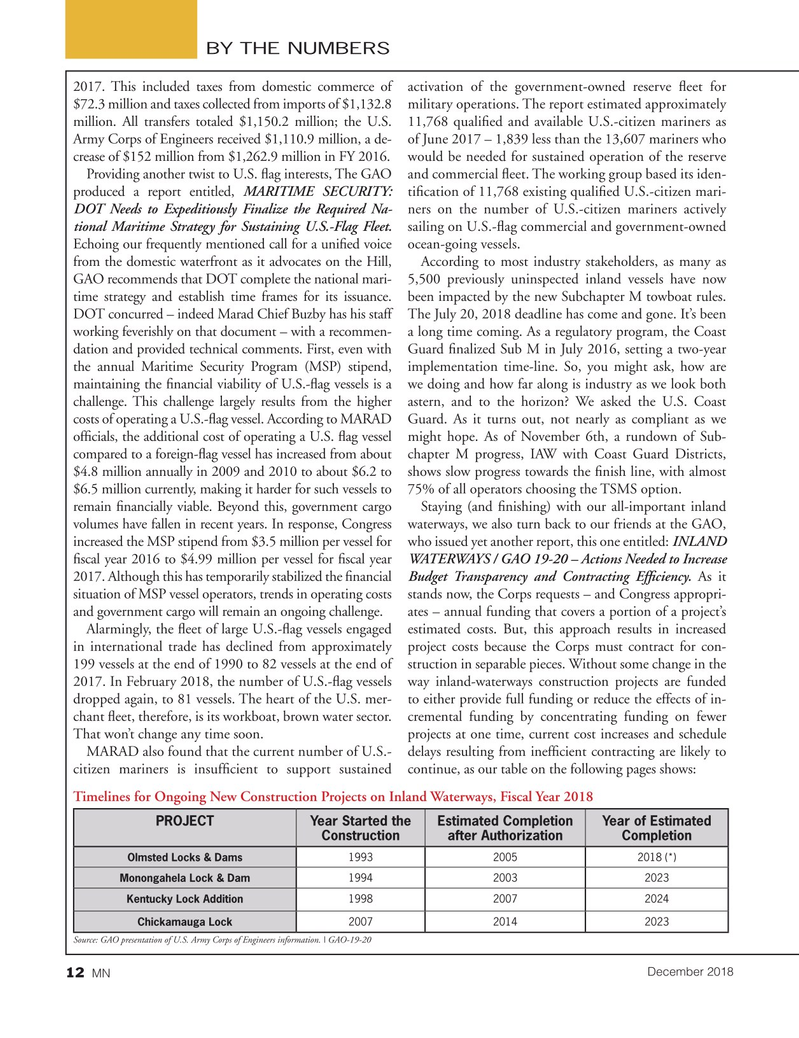
Page 12: of Marine News Magazine (December 2018)
Innovative Products & Boats
Read this page in Pdf, Flash or Html5 edition of December 2018 Marine News Magazine
BY THE NUMBERS 2017. This included taxes from domestic commerce of activation of the government-owned reserve ? eet for $72.3 million and taxes collected from imports of $1,132.8 military operations. The report estimated approximately million. All transfers totaled $1,150.2 million; the U.S. 11,768 quali? ed and available U.S.-citizen mariners as
Army Corps of Engineers received $1,110.9 million, a de- of June 2017 – 1,839 less than the 13,607 mariners who crease of $152 million from $1,262.9 million in FY 2016. would be needed for sustained operation of the reserve
Providing another twist to U.S. ? ag interests, The GAO and commercial ? eet. The working group based its iden- produced a report entitled, MARITIME SECURITY: ti? cation of 11,768 existing quali? ed U.S.-citizen mari-
DOT Needs to Expeditiously Finalize the Required Na- ners on the number of U.S.-citizen mariners actively tional Maritime Strategy for Sustaining U.S.-Flag Fleet. sailing on U.S.-? ag commercial and government-owned
Echoing our frequently mentioned call for a uni? ed voice ocean-going vessels.
from the domestic waterfront as it advocates on the Hill, According to most industry stakeholders, as many as
GAO recommends that DOT complete the national mari- 5,500 previously uninspected inland vessels have now time strategy and establish time frames for its issuance. been impacted by the new Subchapter M towboat rules.
DOT concurred – indeed Marad Chief Buzby has his staff The July 20, 2018 deadline has come and gone. It’s been working feverishly on that document – with a recommen- a long time coming. As a regulatory program, the Coast dation and provided technical comments. First, even with Guard ? nalized Sub M in July 2016, setting a two-year the annual Maritime Security Program (MSP) stipend, implementation time-line. So, you might ask, how are maintaining the ? nancial viability of U.S.-? ag vessels is a we doing and how far along is industry as we look both challenge. This challenge largely results from the higher astern, and to the horizon? We asked the U.S. Coast costs of operating a U.S.-? ag vessel. According to MARAD Guard. As it turns out, not nearly as compliant as we of? cials, the additional cost of operating a U.S. ? ag vessel might hope. As of November 6th, a rundown of Sub- compared to a foreign-? ag vessel has increased from about chapter M progress, IAW with Coast Guard Districts, $4.8 million annually in 2009 and 2010 to about $6.2 to shows slow progress towards the ? nish line, with almost $6.5 million currently, making it harder for such vessels to 75% of all operators choosing the TSMS option. remain ? nancially viable. Beyond this, government cargo Staying (and ? nishing) with our all-important inland volumes have fallen in recent years. In response, Congress waterways, we also turn back to our friends at the GAO, increased the MSP stipend from $3.5 million per vessel for who issued yet another report, this one entitled: INLAND ? scal year 2016 to $4.99 million per vessel for ? scal year WATERWAYS / GAO 19-20 – Actions Needed to Increase 2017. Although this has temporarily stabilized the ? nancial Budget Transparency and Contracting Ef

 11
11

 13
13
